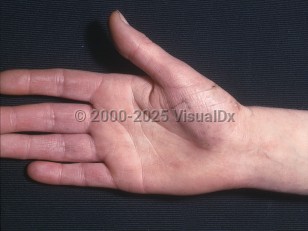Acrocyanosis
Alerts and Notices
Important News & Links
Synopsis

Primary acrocyanosis is asymptomatic, affects digits symmetrically, and is not associated with increased morbidity or mortality. It is most often seen in patients in their 20s and 30s and completely resolves in many women after menopause. The cyanotic discoloration seen in primary acrocyanosis is due to vasospasm in the cutaneous arterioles. Cold climate, outdoor occupation, and low body mass index are risk factors for developing acrocyanosis.
Secondary acrocyanosis can be symmetrical or asymmetrical, and it is sometimes associated with pain and necrosis of the affected extremities. As opposed to primary acrocyanosis, secondary acrocyanosis results from an underlying systemic pathology. It has been associated with many etiologies, including connective tissue diseases, Buerger disease, stroke, myocardial infection, lung diseases causing hypoxia, eating disorders, hematologic disorders, neoplasms, drug exposures, genetic diseases, spinal cord injury, and infections.
Codes
I73.89 – Other specified peripheral vascular diseases
SNOMEDCT:
25003006 – Acrocyanosis
Look For
Subscription Required
Diagnostic Pearls
Subscription Required
Differential Diagnosis & Pitfalls

Subscription Required
Best Tests
Subscription Required
Management Pearls
Subscription Required
Therapy
Subscription Required
Drug Reaction Data
Subscription Required
References
Subscription Required
 Patient Information for Acrocyanosis
Patient Information for Acrocyanosis - Improve treatment compliance
- Reduce after-hours questions
- Increase patient engagement and satisfaction
- Written in clear, easy-to-understand language. No confusing jargon.
- Available in English and Spanish
- Print out or email directly to your patient


